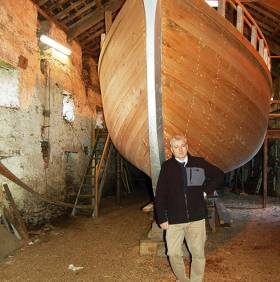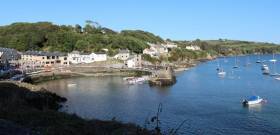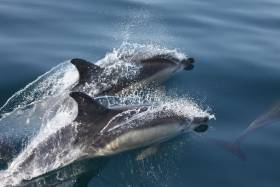Displaying items by tag: Glandore Classic Boat Summer School
There's only four weeks to go until the 2018 Glandore Classic Summer School (21/22 July) which promises to be another excellent event writes organiser Cormac O'Carroll.
We hosted the first Summer school in 1992 and this event has been running biennially since then, this year promised another programme of fascinating speakers, including Gary McMahon on the completion of the AK Ilen Project of Limerick, Hal Sisk on the re-launch of the Dublin Bay 21’s, Simon Keeffe and Tiernan Roe bringing us up to date on the Lady Min, Pat Ruane and Martin O’Donoghue on the recent evolution and future developments of the Currach, Denis Horgan sharing aerial views of West Cork, and a presentation on the proposed OPW Flood Relief scheme for Cork city. And on Saturday evening we have a film presentation ‘The Camino Voyage’ an epic 2,500 modern day Celtic Odyssey from Ireland to northern Spain, presented by Padraig O’Duinnin. We are finalising the details now and the full programme will be announced shortly.
The next Glandore Classic
We have had queries about the dates of the next Glandore Classic. Normally it would have been in July 2019, however, we have been offered an exciting opportunity to partner with RCYC, and have our Classic as part of their 300th Anniversary celebrations. This will be a major international event, and it will attract a much wider range of Classic boats, especially some of the bigger boats that have been missing in the recent years. The detailed Programme will follow but key dates are 12th July for the Cork 300 Parade of Sail and 19th July for the Glandore Classic Regatta Parade of Sail. We would have special Classic events in Cork, and then racing/cruising to Glandore via Kinsale. In Glandore, we would have harbour racing, and cruise/race to Castletownsend, with the possibility of boats continuing on to Baltimore and even Bantry if there is interest. It should be a great event.
This is the good news. But it does mean that we are postponing our Glandore Classic until July 2020. We will be sending regular updates as the programme for Cork 300 forms up. Looking forward to seeing you all there.
If you’ve been wondering just when the current spell of unsettled weather might give way to better conditions, not to mention what has been causing it all in the first place, then the lovely natural harbour and pretty village of Glandore in West Cork is the place to be this weekend writes W M Nixon
Of course, the well-established biennial Glandore Summer School – it alternates with the Glandore Classic & Traditional Boat Regatta and was founded in 1992 – has much more to offer than an insightful presentation on our weather from a maritime perspective. But as the expert in question is Met Eireann’s Vincent O’Shea, who last month was the weather advisor at the Skippers’ Briefing before the Volvo Round Ireland race at Wicklow, his words of wisdom will carry a special resonance.
As ever, the two days of Summer School sessions on Saturday July 16th and Sunday July 17th - organised by Cormac O’Carroll and his team from Glandore Harbour YC in the unique but effective setting of the harbourside Kilfaughnabeg Church in Glandore - will cover a very wide range of topics. But it’s down to serious business immediately at 10.30am on Saturday, when the first speaker is Michael Creed TD, the Minister for the Agriculture, Food and the Marine.
Other speakers will cover a very wide range of topics on issues affecting and assisting maritime communities, particularly as experienced in the southwest. And naturally the traditional and newer boats of the region will be given close attention, with speakers including Gary MacMahon of the Ilen Project at Oldcourt with its boat-building school in Limerick, and expert boat-builders Tiernan Roe and Rui Ferreira, both of whom have their specialised workshops in the Ballydehob neighbourhood, as well as the award-winning Bill Trafford from Mitchelstown.
As for the vital topic of providing genuine sea experience for young people, there’ll be insight into that both from Oliver Hart of the schooner Spirit of Oysterhaven, and Tony McLaughlin of the Brian Boru from Waterford.
Many other areas of interest will be covered in a wide-ranging agenda for which the attendance fee is €20.
Seascapes Podcast: Glandore Classic Boat Summer School, Sailing in West Cork, SmartBay & Open Water Swimming
Hello and welcome aboard this week’s edition of your maritime programme Seascapes – this week we talk to sailing instructor and yachtsman Niall McAllister in Adrigole in West Cork; we have music from Eleanor Shanley and “Sail Away To The Sea”; we preview the Glandore Classic Boat Summer School, we have the second part of our conversation with John Breslin of SmartBay on how he became involved in the maritime world.............. first on Seascapes this week we talk to Open Water swimmer and Steve McQueen fan Ned Denison on the Open Water Swimming calendar and a unique swim in the Southern Hemisphere.......
Ned Denison and Open Water Swimming and that extraordinary swim around Devils Island....the Vibes and Scribes Lee Swim takes place on next Saturday 16th July ..
Originally held in 1914, the annual Vibes and Scribes Lee Swim has become one of the top open water swimming events in Ireland. The course runs through the centre of Cork City, with a distance of around 2 kilometres (1,700m downstream and 300m upstream).
Starting from a specially erected platform at the entrance of the old distillery premises on the North Mall, the contestants swim under all the bridges of the North Channel with the flow of the River Lee until they round the Port of Cork Customs House. They will then continue against the flow of the river to the finishing pontoon in front of the Clarion Hotel.
Most of the swimmers compete for age group prizes, some raise money for local charities and a good number just swim for the enjoyment of the day and the acknowledgement and encouragement of family and friends.......
Congratulations to all in Clontarf Yacht and Boat Club on the completion of the IDRA 14 class wooden dinghy – named “Wicked Sadie” and launched on the last Sunday in June, congratulations to all involved lead by Ronan Melling ...Bravo...
Last week here on Seascapes we talked to John Breslin of Smart Bay well while we were discussing the observatory in Galway Bay and the new technologies that it harnesses we wondered how he became involved in the maritime world .........
John Breslin on the exciting world of technology and the marine and the Smart Bay Observatory ....next week here on Seascapes we’ll hear about a new SeaScience App developed by the Ryan Institute at NUI Galway.....we’ll be talking to Martina Prendergast
........well from Galway to the Glandore Classic Boat Summer School which is on next weekend on Saturday 16th we have all the details on the Seascapes webpage..... speakers include Rui Ferreira, Oliver Hart, Donal Hayes, Dr.Breda Kenny, Dr Charles Luddington, Padraig Whooley, Gary McMahon, John O’Connell, Simon O’Keeffe, Vincent O’Shea, Tiernan Roe, Bill Trafford and others.
Next here on Seascapes to Adrigole in West Cork and sailing instructor , mariner and yachtsman Niall McAllister from the West Cork Sailing and Powerboat Centre .....Niall told us how he became involved and about “Jessy” his Sun Odyssey 37 ....































































